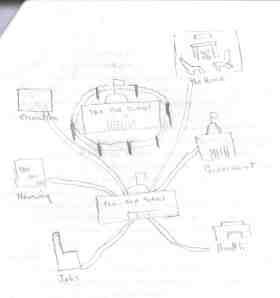
In my last post I talked about the Eight-Year-Study, which documented the success of progressive education at fostering intellectual curiosity, cultural awareness, practical skills, a philosophy of life, a strong moral character, emotional balance, social fitness, sensitivity to social problems, and physical fitness.
I had come across materials related to the study in the Progressive Education Association Records in the University of Illinois Archives. This is a treasure-trove, not only of the Progressive Education Association per se, but also of the various social movements they were involved in. I hope to explore it more.
One drawing I found is shown here. It’s included in the folder for the booklet that later appeared as Dare our secondary schools face the atomic age? However, there are no images in that booklet. The drawing shows two visions for schools. In one, the “old school,” there is a fence surrounding the building; activities of the school are separate from those of the world around it, and as a result, schooling is separated from the actual life of the children.
In a second vision, the “new school,” the building is substantially the same, but it is connected to sites for recreation, housing, jobs, health, government, and by implication, all aspects of life. This idea of community-based schools was key to the Progressive Education movement, especially in its later years, as members realized they needed to do more than promote child-centered learning in an individual sense. That was true for “community schools” per se (Clapp, 1939), but actually for all schools, urban or rural, large or small, primary or secondary.
Today, many of these ideas have survived under rubrics such as “civic engagement,” “public engagement,” “community-based learning,” or “service learning.” But often those ideas are seen as one-way or very limited in scope, as in a single course. It’s worth revisiting the earlier visions to understand better how schools and universities could better fulfill the high hopes we place upon them.
References
Benedict, Agnes E. (1947). Dare our secondary schools face the atomic age?. New York: Hinds, Hayden & Eldredge.
Benedict, Agnes E. (1947). Pencil drawing, Progressive Education Association Records, 1924-1961, Record Series 10/6/20, Box 4, folder Dare the Schools Face the Atomic Age?, University of Illinois Archives.
Clapp, Elsie Ripley (1939). Community schools in action. New York: Viking.

Good question. I’d say that the web model is an aspiration for online learning, but not always an actuality. One place to look is the work on ubiquitous learning.
Watch for the new book edited by Bill Cope–Ubiquitous Learning (University of Illinois Press). I have a chapter there called, “Ubiquitous learning, ubiquitous computing, and lived experience” http://illinois.edu/goto/08ubi
LikeLike
Chip.
I’ve been thinking a bit about this, particularly in the ways that education so often tends to use tools (e.g moving from the PC to the laptop to cell phones or ipods as in themselves solutions to student engagement and learning. As you so well note, this idea reflects the dominant fenced in school model so nicely illustrated here.
Since I’ve been mulling over some things about distance learning, this post has me thinking that the integrative ‘new school’ model is a great one for distance education, in the ways that students and teachers come together to learn, but do so while remaining very much in their environment. The ‘new school’ model seems like a great metaphor for thinking about online learning & teaching. I’d love to know if you have resources on this : ). Someone has probably written about this…
Linda Vigdor
LikeLike